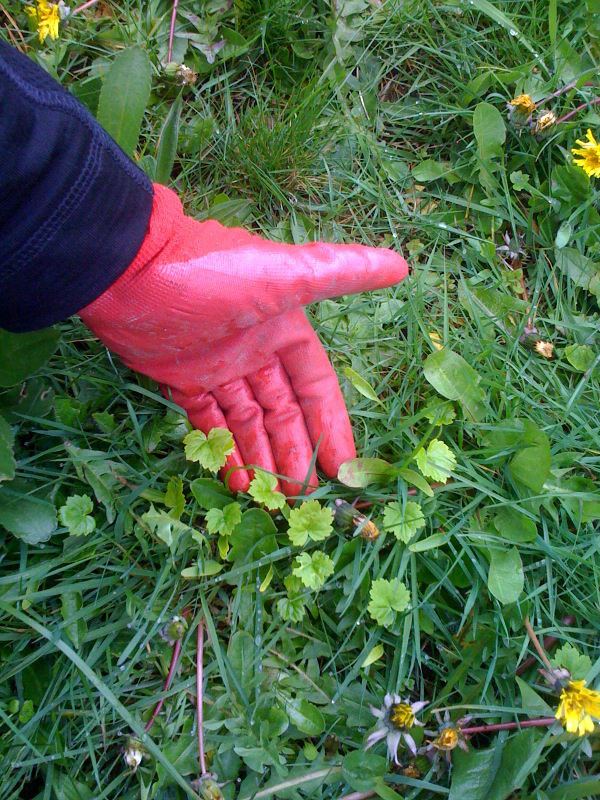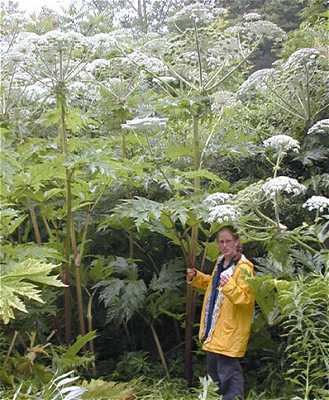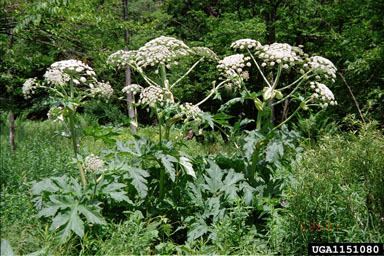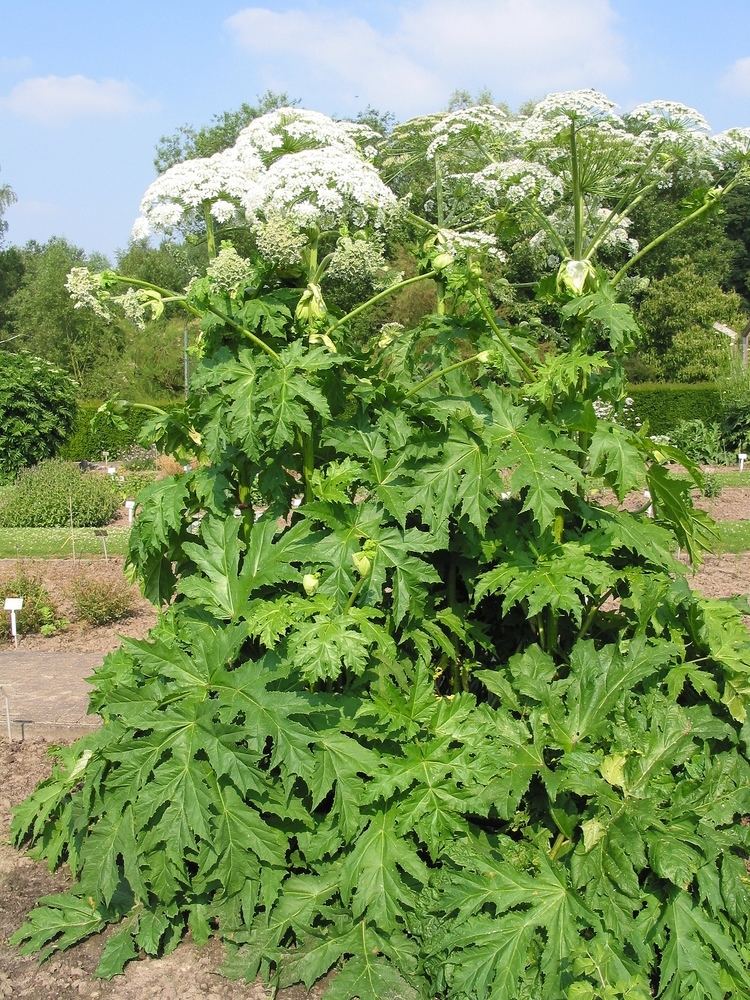Rank Species | Higher classification Cow Parsnip | |
 | ||
Similar Cow Parsnip, Hogweed, Impatiens glandulifera, Japanese knotweed, Umbelifers | ||
Invasion giant hogweed heracleum mantegazzianum identification
Heracleum mantegazzianum, commonly known as giant hogweed, cartwheel-flower, giant cow parsnip, hogsbane or giant cow parsley, is a plant in the family Apiaceae. In New Zealand, it is also sometimes called wild parsnip, or wild rhubarb. It typically grows to heights of 2–5.5 m (6 ft 7 in–18 ft 1 in). Superficially, it resembles common hogweed (Heracleum sphondylium), Heracleum sosnowskyi, or garden angelica (Angelica archangelica). It is phototoxic and considered to be a noxious weed in many jurisdictions. Giant hogweed is native to the Caucasus region and Central Asia. It was introduced to Britain as an ornamental plant in the 19th century, and it has also spread to many other parts of Europe, the United States, and Canada.
Contents
- Invasion giant hogweed heracleum mantegazzianum identification
- Giant hogweed heracleum mantegazzianum highly dangerous plant
- Description
- Introduction to Western Europe and North America
- Phototoxicity
- Countermeasures
- In popular culture
- References

The sap of giant hogweed causes phytophotodermatitis in humans, resulting in blisters and long-lasting scars. These serious reactions are due to the furocoumarin derivatives in the leaves, roots, stems, flowers, and seeds of the plant.

Giant hogweed heracleum mantegazzianum highly dangerous plant
Description

Giant hogweed has a stout, bright green stem that is frequently spotted with dark red and hollow red-spotted leaf stalks that produce sturdy bristles. The stems grow to more than 2 m high. The hollow stems vary from 3–8 cm (1.2–3.1 in) in diameter, occasionally up to 10 cm (3.9 in). Each dark red spot on the stem surrounds a hair, and large, coarse white hairs occur at the base of the leaf stalk. The plant has deeply incised compound leaves which grow up to 1–1.7 m (3 ft 3 in–5 ft 7 in) in width.

Giant hogweed is a biennial or monocarpic perennial, the plants usually begin dying after they have set seed. It usually flowers in its second year from late spring to midsummer, with numerous white flowers clustered in an umbrella-shaped head that is up to 80 cm (31 in) in diameter across its flat top. The plant produces 1,500 to 100,000 flattened, 1-centimetre (0.39 in)-long, oval, dry seeds that have a broadly rounded base and broad marginal ridges. Tall dead stems may mark its locations during winter.
Introduction to Western Europe and North America

Giant hogweed was among many foreign plants introduced to Britain in the 19th century as ornamental plants. It is now widespread throughout the British Isles, especially along riverbanks. By forming dense stands, they can displace native plants and reduce wildlife habitats. It has spread in the northeastern and northwestern United States, and southern Canada and is an invasive species in Germany, France, and Belgium, overtaking the local native species, Heracleum sphondylium.
In Canada, the plant has been sighted in British Columbia, Alberta, Saskatchewan, Ontario, Quebec, New Brunswick, Nova Scotia, and in isolated areas of Newfoundland. It has been seen in Quebec since the early 1990s. The plant's spread in Ontario began in the southwest and was seen in 2010 in the greater Toronto area and Renfrew County near Ottawa.
Giant hogweed was introduced into New York about 1917, and was recorded in British Columbia in the 1930s. It now occurs in the west in British Columbia, Washington, and Oregon and in eastern North America from Newfoundland and Nova Scotia west to Ontario and Wisconsin and south to Indiana, Maryland, and New Jersey. It is also recorded occasionally in Michigan It is a federally listed noxious weed in many states.
Phototoxicity
The sap of the giant hogweed plant is phototoxic; when the contacted skin is exposed to sunlight or to ultraviolet rays, it can cause phytophotodermatitis (severe skin inflammations). Initially, the skin colours red and starts itching. Blisters form as it burns within 48 hours. They form black or purplish scars that can last several years. Hospitalisation may be necessary. Although many media reports on giant hogweed suggest the plant can lead to temporary or permanent blindness, existing research on the plant does not back up this claim.
These reactions are caused by the presence of linear derivatives of furanocoumarin in its leaves, roots, stems, flowers, and seeds. These chemicals can get into the nucleus of the epithelial cells, forming a bond with the DNA, causing the cells to die. The brown colour is caused by the production of melanin by furocoumarins.
Authorities advise that children should be kept away from giant hogweed, that protective clothing, including eye protection, should be worn when handling or digging it, and that if skin is exposed, the affected area should be washed thoroughly with soap and water and the exposed skin protected from the sun for several days.
Countermeasures
Because of its phototoxicity and invasive nature, giant hogweed is often actively removed. In the UK, the Wildlife and Countryside Act 1981 makes it an offence to plant or cause giant hogweed to grow in the wild. Hogweed is regulated as a federal noxious weed by the US government, and is illegal to import into the United States or move interstate without a permit from the Department of Agriculture. The USDA Forest Service states pigs and cattle can eat it without apparent harm. The New York State Department of Environmental Conservation has had an active program to control giant hogweed since 2008, including reporting, database maintenance, and crews for removal or herbicide control. In 2011, Maine state horticulturists, describing the plant as "Queen Anne's lace on steroids", reported that it has been found at 21 different locations in Maine, with the number of plants ranging from one to a hundred.
In popular culture
The 1971 album Nursery Cryme by the progressive rock group Genesis contains a song called "The Return of the Giant Hogweed". The lyrics describe a murderous attack on the human race by Heracleum mantegazzianum, long after the plant was first "captured" and brought to England by a Victorian explorer.
